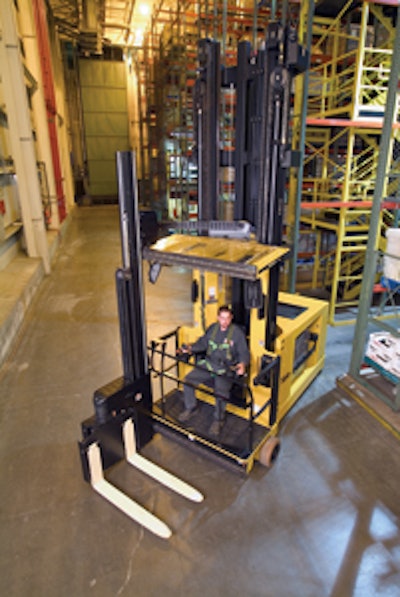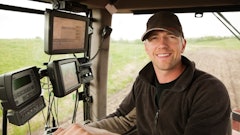
We all know the challenges facing warehouse operations, especially when it comes to maximizing cube efficiently to beat the rising costs of warehouse space.
"What you continue to see in food and grocery DCs are narrower aisles and higher racking systems to get as much product under one roof and within the smallest cube space as possible," notes Dale Guckian, warehouse product manager for Yale Materials Handling Corp,, Greenville, NC.
"Warehouses and DCs are saving floor space by using higher vertical warehousing and lift trucks designed to meet these requirements," adds John Colborn, marketing director for The Raymond Corp. in Greene, NY. "Utiliza-tion of space and cube is so critical because warehouse space is very expensive."
To help food companies reach higher racks, some lift truck manufacturers are offering AC (alternating current) motors, which offer a number of advantages including faster acceleration, higher efficiency and lower maintenance costs.
AC powered lift trucks run off of DC batteries and convert the DC power back to AC to power the motor.
"Many companies have already started introducing AC technology across their entire electric product lineup to enhance the performance and productivity of the units, as well as to reduce the overall cost of ownership," notes Cesar Jimenez, electric product planning and product marketing manager for Toyota Material Handling USA, Irvine, CA.
AC technology is being used not only in narrow-aisle applications, but throughout the warehousing industry, notes Matt Ranly, senior product manager for Crown Equipment Corp. in New Bremen, OH. "AC does offer some inherent advantages over DC, but Crown took time to evaluate and understand the real AC advantages and where it could add value for our customers. We are the only lift truck manufacturer designing and building our own AC motors here in the U.S."
Ranly states some in the industry are under "a real misconception that AC will lower the amount of energy or that AC will prolong battery life by 25 percent to 50 percent. In reality, there is a marginal improvement in battery life. There are real benefits of AC and one is there are no brushes, which means lower maintenance. Another benefit is giving the operator a much smoother feel in operating the truck, which could lead to better control and higher productivity."
Warehouse managers want highly productive and efficient workhorses in their narrow-aisle forklift trucks to complement and enhance the work their operators do. "Everyone in the industry is looking for equipment offering faster throughput and higher productivity," says Ranly.
They also want energy-efficient equipment to help reduce overall cost of ownership, adds Ilidio Alves, director of marketing and product development for Nissan Forklift Corp. in Marengo, IL. Manufacturers, heeding customers' requirements, are using advanced technologies to help warehouse operators meet these diverse requirements.
For instance, Nissan's recent launch of its Platinum II series of fuel-efficient lift trucks meet EPA requirements for emissions for internal combustion engines, notes Alves. "It also has special features on the transmission, allowing customers to save in terms of tire wear and wear-and-tear of the machine without reducing the efficiency of the operation. So customers gain the lowest cost of operation, which is really what Nissan has been focusing on this year."
Lower Cost Of Maintenance
Universally, there is a continued migration to AC controls in material handling equipment, including AC traction systems and optional AC lift systems, says Guckian at Yale. "To advance our position, we've come to market with not only AC traction and lift systems, but with AC power steering systems as well, a first in the North American market in narrow-aisle reach equipment."
Yale's new CAN-BUS digital communication system reduces the amount of wiring and connectors by 45 percent, Guckian says. "By reducing the amount of wiring and connectors, you minimize exposure to failure and reduce the cost of maintenance. There are a lot of repairs associated with traditional lift trucks from broken wires and corroded or contaminated connectors due to dust and moisture."
Hyster recently launched its new AC reach truck. "The simplicity of design and the efficiency of AC motors and performance ratings of those motors allow us to achieve our two main goals: reliability of operation and therefore higher uptime and the ability to keep the cost of operation at the lowest level," says George Marshall, director of sales development for warehouse products at Hyster Co., Greenville, NC.
An industry first for Hyster is its AC Walker-Rider product offering power-assist steering. "This allows companies to hire diverse operators—and not just strong individuals who can handle that type of equipment—where steering effort is a particularly important element," notes Marshall. "Now companies can choose from a wider range of operators in varying size and strength who can be equally productive using this equipment."
The Raymond Corp.'s 7420 and 7440 Reach-Fork truck series perform with heavier load capacities at today's higher heights, for both storage and retrieval. Both units come equipped with Raymond's ACR System with AC motors on lift and drive functions for quicker acceleration, smoother direction changes and precise traction and lift. Model 7420 lifts up to 421 inches with a 4,500-pound capacity and a 3,200-pound double-deep reach capacity.
Raymond's Model 7440 lifts up to 444 inches with a 4,500-pound load capacity and a 3,200-pound double-deep reach capacity. "The enhanced mast height and load capacity, combined with Raymond's unique open view mast, are a perfect fit for warehouses with very tall racking," Colborn says.
Toyota's Jimenez adds: "Companies are constantly looking into the development of new products and technologies that will enhance the customer's bottom line. For some, partnering with other companies has been the answer in regards to RFID, fast charging, and fleet management and maintenance solutions."
Optimizing Performance
Lift trucks are getting smarter and smarter. For instance, Yale's bi-directional lift pump and AC motor (an industry first) increases both productivity and efficiency, notes Guckian. "Historically, if your forks were in the air, you would have to rely on gravity to lower them, so if you were lowering empty, the forks lowered more slowly than when loaded."
The bi-direction pump is unique in that it pushes fluid into the cylinder during the lift cycle and then runs in reverse direction during the lowering cycle, thereby creating powered lowering capabilities. "So our lowering speeds are the same whether the forks are loaded or empty (which is about 50 percent of the time), which shortens the lift/lower cycle time, boosting productivity," explains Guckian.
But there's more to the bi-directional story. As loaded forks lower, the motor is being regenerated as mechanical energy is captured and converted into electrical energy by means of a regenerative motor circuit. "This means we are actually putting power back into the battery, improving efficiency so the truck can run longer between charges," Guckian says.
Crown Equipment developed its Access-123 comprehensive control system, which incorporated modules through which data is collected and shared. "By utilizing all the information collected, we can optimize the truck's performance," explains Ranly. Information could include truck direction and speed, fork height, how much weight they are carrying, motor temperature and whether the operator is standing or sitting.
"As the operator continues to make choices in operating his truck, Access 123 constantly evaluates the current operation conditions and controls the truck movements in the safest, most productive manner, optimizing such functions as how fast the truck can move and how sharply it can turn. All of this is done in real time."
Ranly stresses Crown's commitment to its vertical manufacturing capabilities. "We know the level of performance we want up front to optimize the performance of our lift trucks. When you buy off-the-shelf components, you have to take what you get."
He adds the company designs and manufactures about 85 percent of all the components manufactured into Crown lift trucks. This includes motors and AC motors as well. "We know exactly what torque, temperature and speed we want our motors to perform to," Ranly continues.
Crown is also the first lift truck manufacturer to design and support an asset utilization system, says Ranly. InfoLink is a new Web-based, wireless system that organizes, collates and stores data collected during the truck's operation.
"InfoLink gives customers real-time information they need to make better decisions about how their fleets are operating," explains Ranly.
"The system monitors and controls a wide range of functions including impact reporting, hour-meter data collection, operator certification, fleet utilization and pre-use OSHA inspection reports."
Future Trends
Fleet management is a definite trend to watch in the coming years, notes Marshall at Hyster. According to Marshall, up to 15 percent of warehouse fleets are managed and maintained by 3PLs and up to 20 percent are managed and maintained by OEM forklift truck providers, for an industry total of about 35 percent.
"This trend is growing and within five years that percentage will double to about 70 percent in the food and grocery industry," Marshall says. "Companies are moving toward leasing and maintenance—or rental and maintenance—agreements through the 3PLs and OEMs who are literally managing the entire warehousing process. So they are simply sending their goods to a warehouse to be stored and handled by someone else with a contract to get the goods delivered on time to their ultimate destination."
The advantage to customers is that they can count on a fixed cost to rely on because it is contracted, Marshall says.
"Then, in terms of the soft costs with things like insurance and workers' compensation, once you have a contract in which an operator is part of the package, those elements are put back in the hands of the provider," he says.



















